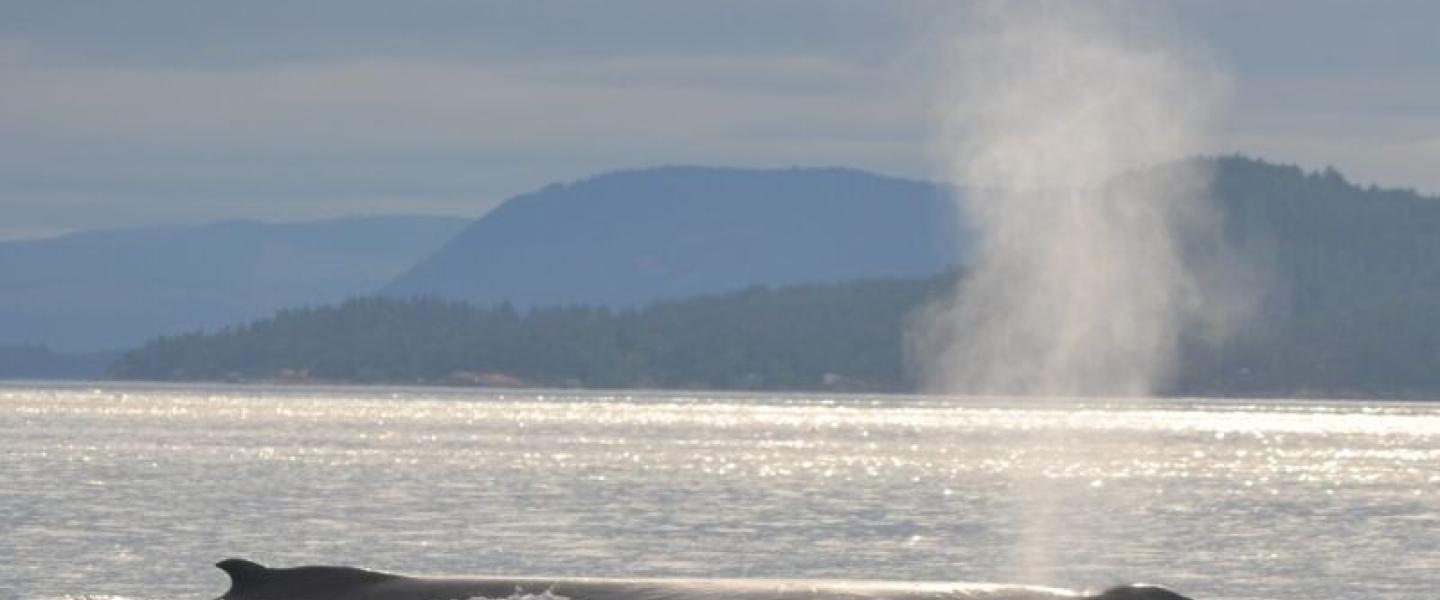
Sarah | 09/13/2019 | M/V Kestrel | 11:00am
Today was just a lovely day on the water! With calm seas and some reports of several baleen whales in our area, Captain Gabe and I were eager to hit the water.
We started our day heading south from Friday Harbor through San Juan Channel towards Cattle Pass between San Juan Island and Lopez Island. We stopped for a brief look at some Steller’s sea lions hauled out on a rocky outcropping known as Whale Rocks. These massive pinnipeds are the largest sea lions on the world, with males topping out at 12 feet long and 2,400 pounds. We shut the boat down and listened to their growly bellows and we could even smell them while we were downwind! We also saw Heerman’s gulls, pelagic cormorants, and glaucous-winged gulls up on the rock. All of these animals contribute nitrogen to the marine environment around the rocks supporting a vibrant bull kelp forest that provides habitat for creatures as large as the sea lions all the way down to our smallest marine invertebrates in the Salish Sea.
We decided to push further south to and west out into the confluence of the Strait of Juan de Fuca and Haro Strait. We were on the search for food that would feed a whale! Oftentimes when we look for whales we are actually looking for bird activity over the surface of the water. We found a number of baitball aggregations, or birds feeding on fish being pushed up to the surface of the water by any number of underwater predators. Bird-wise we saw common murre, several gull species, rhinoceros auklets, and cormorants feeding on the small fish, probably either sandlance or herring.
As we watched the baitball all of a sudden, WHOOSH! A humpback whale surfaced within a mile of the boat! These massive whales are 45 feet long on average here in the North Pacific, and can weigh as much as seven African elephants. We are entering what we consider to be peak season for humpbacks in the Salish Sea as they work on fattening up before their long migration to their breeding and calving grounds in Mexico and Hawai’i. We had a great encounter with the whale, watching it surface and feed in and amongst rafts of common murre father-chick pairs. On one surfacing we got excellent looks at the barnacles on the whales’ head! Humpback whales can carry as much as a ton of barnacles and other parasites on their bodies! As we were getting ready to leave the whale fluked up, raising its massive tail into the air before taking a dive. By looking at the unique pattern underneath the whale’s flukes we were able to identify it as MMX0006 “Double Drop,” a catalogued humpback in our area.
We decided to leave the humpback to go on a search to see if we could find any other whales in our area.
As we cruised across Hein Bank we found a pair of feeding minke whales! These small whales are the second smallest baleen whale in the world, still measuring in at around 30 feet long! We watched as the whales fed in the shallow waters of the bank. As we sat with the whales, I scooped a piece of free floating bull kelp out of the water for our guests to touch. Bull kelp can reach lengths of 120 feet long and usually grows in areas of high current. This time of year, just like how trees lose their leaves, kelp starts pulling off of their holdfasts and dying for the season. Each year a whole new kelp forest grows! We got great looks at the minke whale before deciding to push further north and circumnavigate San Juan Island.
As we travelled, we got great looks at harbor porpoise surfacing around the boat. These small cetaceans are some of our more common marine mammals in the Salish Sea. They are small bodied, and typically are gray to brown in coloration with a small, chocolate-chip shaped dorsal fin. These days we are seeing lots of mom and calf pairs in our waters. Here in the San Juan Islands the majority of these adorable calves are born in the late summer or early fall.
We made a stop at Spieden Island to look for some of the non-native animals introduced to its slopes in the 1960’s to establish a hunting preserve. The preserve is long since abandoned, but some of the species still persist on the island. We got great looks at some of the moufalon sheep and fallow deer that call the island home, and kept our eyes peeled for any of the sika deer that also inhabit the island to no avail. We also got some great looks at a group of about a dozen turkey vultures feeding on a carcass up on the bare slope of the island.
After a very full trip and a lot of water covered, we headed back into Friday Harbor. Today truly showcased the diversity of the San Juan islands and our surrounding waters. I feel very lucky to call this place my office and to be able to share such amazing wildlife with our guests. I can’t wait to see what tomorrow holds!